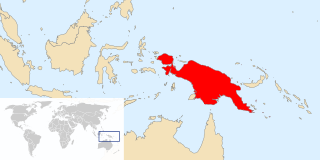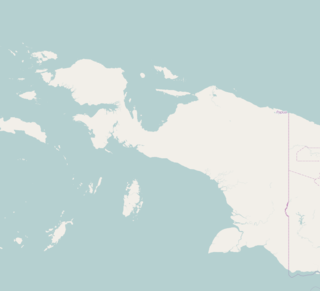The East Papuan languages is a defunct proposal for a family of Papuan languages spoken on the islands to the east of New Guinea, including New Britain, New Ireland, Bougainville, Solomon Islands, and the Santa Cruz Islands. There is no evidence that these languages are related to each other, and the Santa Cruz languages are no longer recognized as Papuan.

Melanesians are the predominant inhabitants of Melanesia. Most speak either one of the many Austronesian languages, especially in the Oceanic branch of Malayo-Polynesian, or one of the Papuan languages. Other languages spoken are the numerous creoles or pidgins in the region, such as Tok Pisin, Hiri Motu, Solomon Islands Pijin, Bislama, and Papuan Malay. Melanesians occupy islands in a wide area from Eastern Indonesia to as far east as the islands of Vanuatu and Fiji.
Taiap is an endangered language isolate spoken by around a hundred people in the East Sepik Province of Papua New Guinea. It is being replaced by the national language and lingua franca Tok Pisin.
Taba is a Malayo-Polynesian language of the South Halmahera – West New Guinea group. It is spoken mostly on the islands of Makian, Kayoa and southern Halmahera in North Maluku province of Indonesia by about 20,000 people.

The Mantion–Meax or East Bird's Head languages form a language family of three languages in the "Bird's Head Peninsula" of western New Guinea, spoken by 20,000 people.
The Sepik languages are a family of some 50 Papuan languages spoken in the Sepik river basin of northern Papua New Guinea, proposed by Donald Laycock in 1965 in a somewhat more limited form than presented here. They tend to have simple phonologies, with few consonants or vowels and usually no tones.

The North or West Bougainville languages are a small language family spoken on the island of Bougainville in Papua New Guinea. They were classified as East Papuan languages by Stephen Wurm, but this does not now seem tenable, and was abandoned in Ethnologue (2009).

The Central Solomon languages are the four Papuan languages spoken in the state of the Solomon Islands.

The South or East Bougainville languages are a small language family spoken on the island of Bougainville in Papua New Guinea. They were classified as East Papuan languages by Wurm, but this does not now seem tenable, and was abandoned in Ethnologue (2009).
The Baining or East New Britain languages are a possible small language family spoken by the Baining people on the island of New Britain in Papua New Guinea. They were classified as East Papuan languages by Wurm, but this does not now seem tenable.

New Guinea is a large island separated by a shallow sea from the rest of the Australian continent. It is the world's second-largest island, after Greenland, covering a land area of 785,753 km2 (303,381 sq mi), and the largest wholly or partly within the Southern Hemisphere and Oceania.

Saukorem is a coastal village in West Papua, Indonesia, located about 125 km (75 mi) north-northwest of Manokwari. The town is located on the northern coast of the Bird's Head Peninsula and administratively it is the principal settlement of Amberbaken subdistrict of the Manokwari Regency.

Tehit is a Papuan language of the Bird's Head Peninsula of New Guinea. Other spellings are Tahit, Tehid, and other names Kaibus, Teminabuan. Dialects are Tehit Jit, Mbol Fle, Saifi, Imyan, Sfa Riere, Fkar, Sawiat Salmeit. A grammar sketch can be found in Don Flassy's 1991 Leiden University M.A.. thesis.

Mpur, is a language isolate spoken in parts of the Bird's Head Peninsula of New Guinea. It is not closely related to any other language, and though Ross (2005) tentatively assigned it to the West Papuan languages, based on similarities in pronouns, Ethnologue and Glottolog list it as a language isolate. Mpur has a complex tonal system with 4 lexical tones and an additional contour tone, a compound of two of the lexicals. Its tonal system is somewhat similar to the nearby Austronesian languages of Mor and Ma'ya.

Hatam is a divergent language of New Guinea. Apart from Mansim (Borai), formerly listed as a dialect, it is not closely related to any other language, and though Ross (2005) tentatively assigned it to the West Papuan languages, based on similarities in pronouns, Ethnologue and Glottolog list it as a language isolate or small independent family.

Abun, also known as Yimbun, Anden, Manif, or Karon, is a West Papuan language spoken along the northern coast of the Bird's Head Peninsula. It is not closely related to any other language, and though Ross (2005) assigned it to the West Papuan family, based on similarities in pronouns, Ethnologue and Glottolog list it as a language isolate.

Meyah (Meax) is a West Papuan language spoken in the Manokwari Regency of West Papua, Indonesia. The Meyah language is agglutinative and head-marking, and has no grammatical cases. It has subject-object-verb word order, which comes from nearby Austronesian languages.
Lenakel, or West Tanna, is a dialect chain spoken on the western coast of Tanna Island in Vanuatu.

Mansim, also known as Borai or Moi Brai, is a West Papuan language of the eastern Bird's Head Peninsula closely related to Hattam. As of 2010 there are rumours of 50 elderly speakers.








